Tim Mosso visits the New York International Auto Show 2024 Part 2: This Time It’s a Celebration of Petrol Engine Power!
by Tim Mosso
In my first 2024 New York International Auto Show round-up, I reflected on the decline of auto shows generally, the NYIAS’ surprisingly pervasive exhibition of vintage cars, and the rise of electric vehicles. All are signs of the times.
But sex still sells in the auto industry, and gas-burning performance is sexy. Despite the rise of electric speed, we’re simultaneously living in a golden age of carbon-combusting horsepower. Check your nostalgia at the door, because literally nothing made in the 1960s or 70s can touch this modern metal.
Ford Mustang GTD
Ford showed up with the direct successor to its 2016 Le Mans-winning Ford GT supercar. And that successor is a Mustang. Hold your fire; this ‘stang is worth the GT’s mantle. Although dubbed “GTD,” the new car is both more exotic in construction and more powerful than the actual IMSA GTD class Mustang race car.
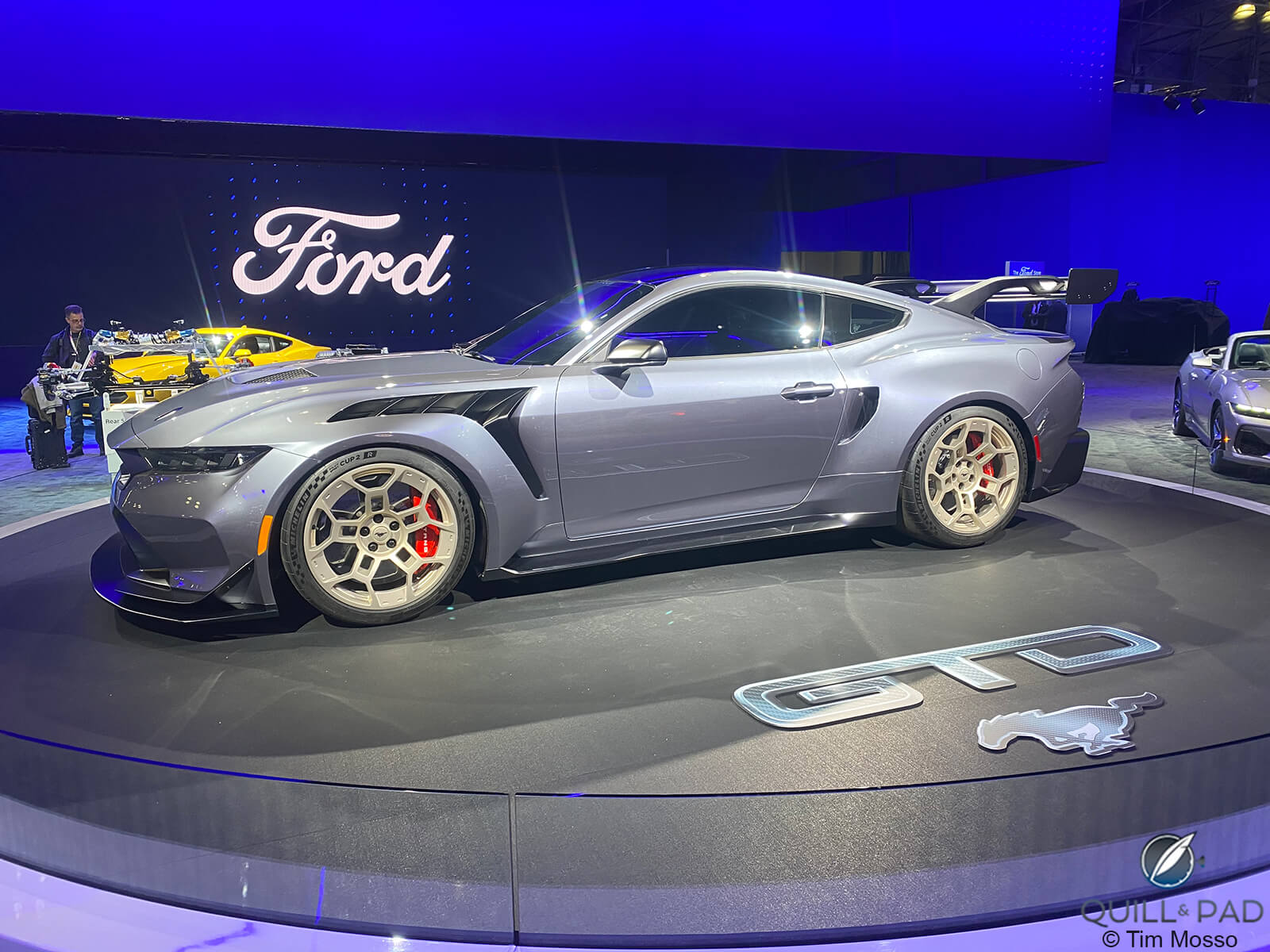
Ford Mustang GTD
The Mustang GTD’s structural core begins life on the assembly line at the Flat Rock, Michigan, factory that builds all its sisters. But the GTD-to-be takes a wild turn towards Markham, Ontario where Ford GT constructor and longtime Ford racing partner Multimatic completes the car’s radical mutation from its core genus. Each Mustang of this breed will be hand-built by a race car shop.
Virtually all of the Mustang GTD’s steel unibody is cloaked in carbon fiber. An eight-speed dual-clutch transmission occupies the center of a GTD-exclusive integrated rear transaxle while receiving the car’s likely 600-700lb/ft of torque through a carbon fiber driveshaft. Due to the transaxle and rearward-shifted engine mounts, the Mustang GTD will exhibit near 50:50 weight distribution.
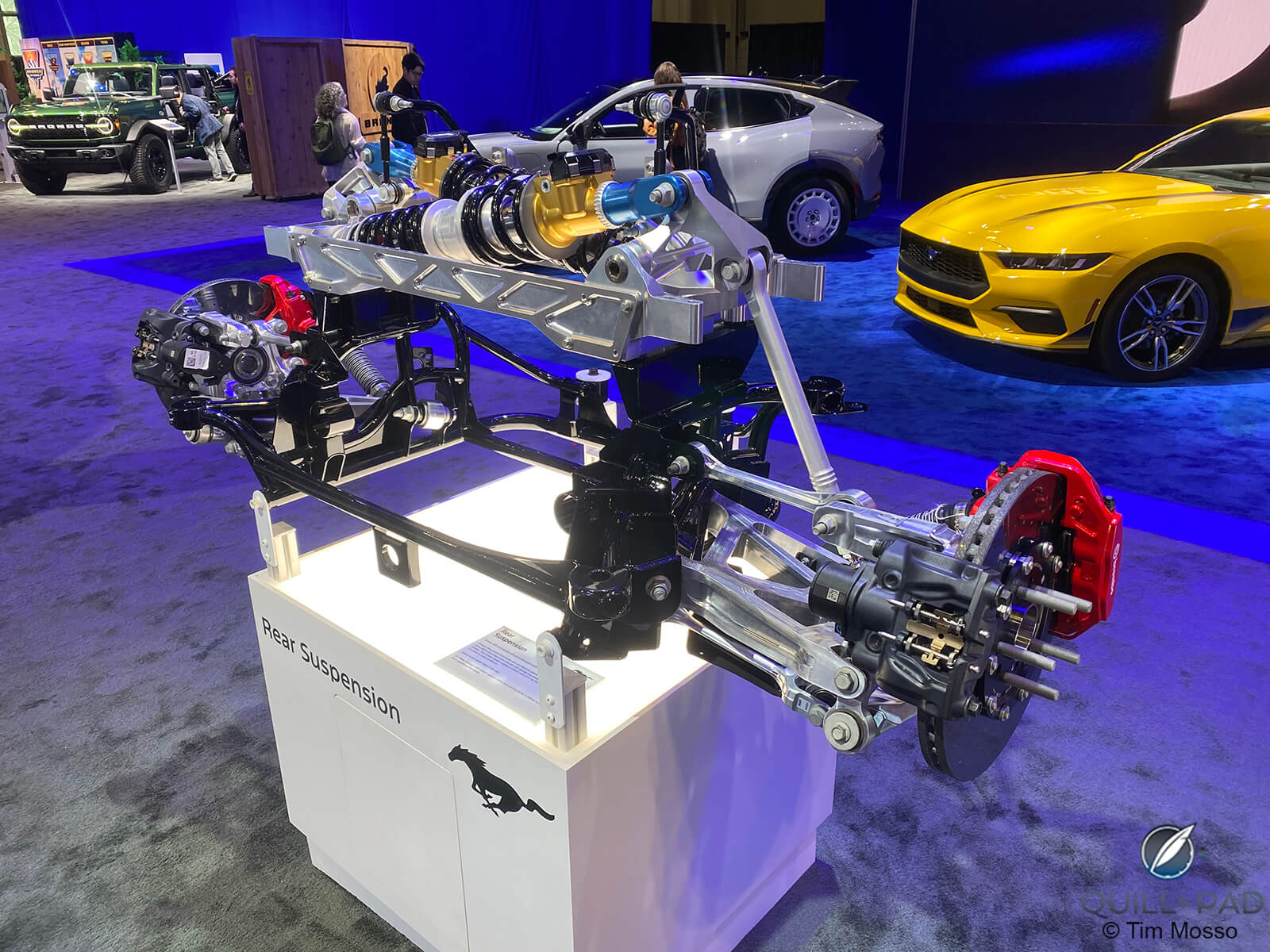
Ford Mustang GTD rear suspension
Bellcrank-activated inboard pushrod rear suspension keeps the center of gravity low. Machined suspension members look raw, chiseled, and hardcore; they also triumph as works of automotive art.
———————————————————————————
———————————————————————————
Because the Mustang GTD is a road car, not a race car, Ford can use tech not permitted in sanctioned competition. Active aerodynamics arrives in the form of servo-movable surfaces. While the GT3-spec IMSA Mustang is limited to around 550 naturally aspirated horses, the road car knows no boundaries.
Under the hood, the previous generation Shelby GT500’s supercharged and aftercooled 5.2-liter V8 rises to over 800 horsepower (exact numbers pending).
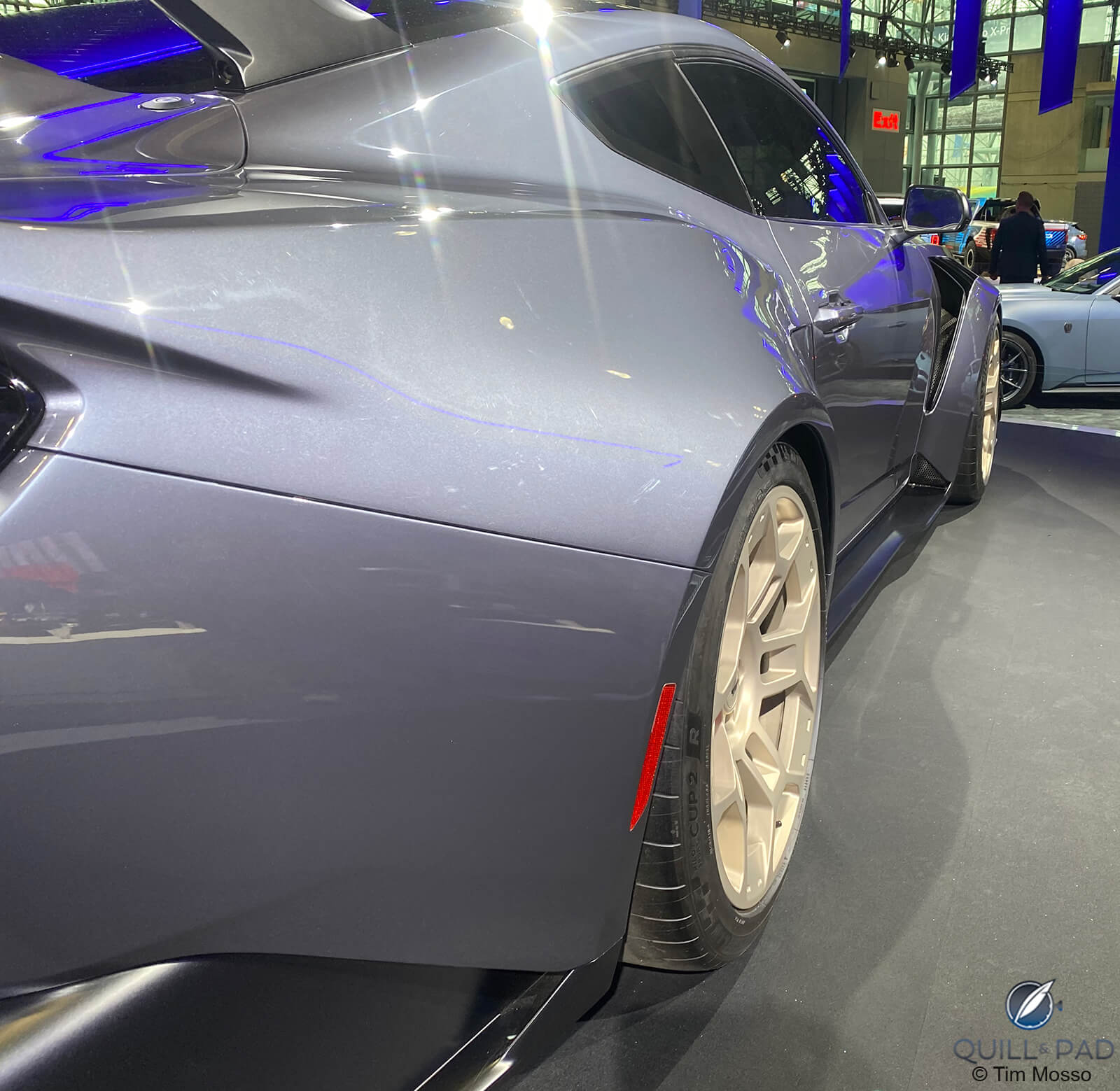
Massively flared rear wheel arch of the Ford Mustang GTD
All four corners benefit from Multimatic’s race-bred spool valve shocks. Not only do these electronically-adjustable dampers boast multiple compression and rebound settings, but they can drop the car 40mm (1.6 inches) on command; none of that is race-legal.
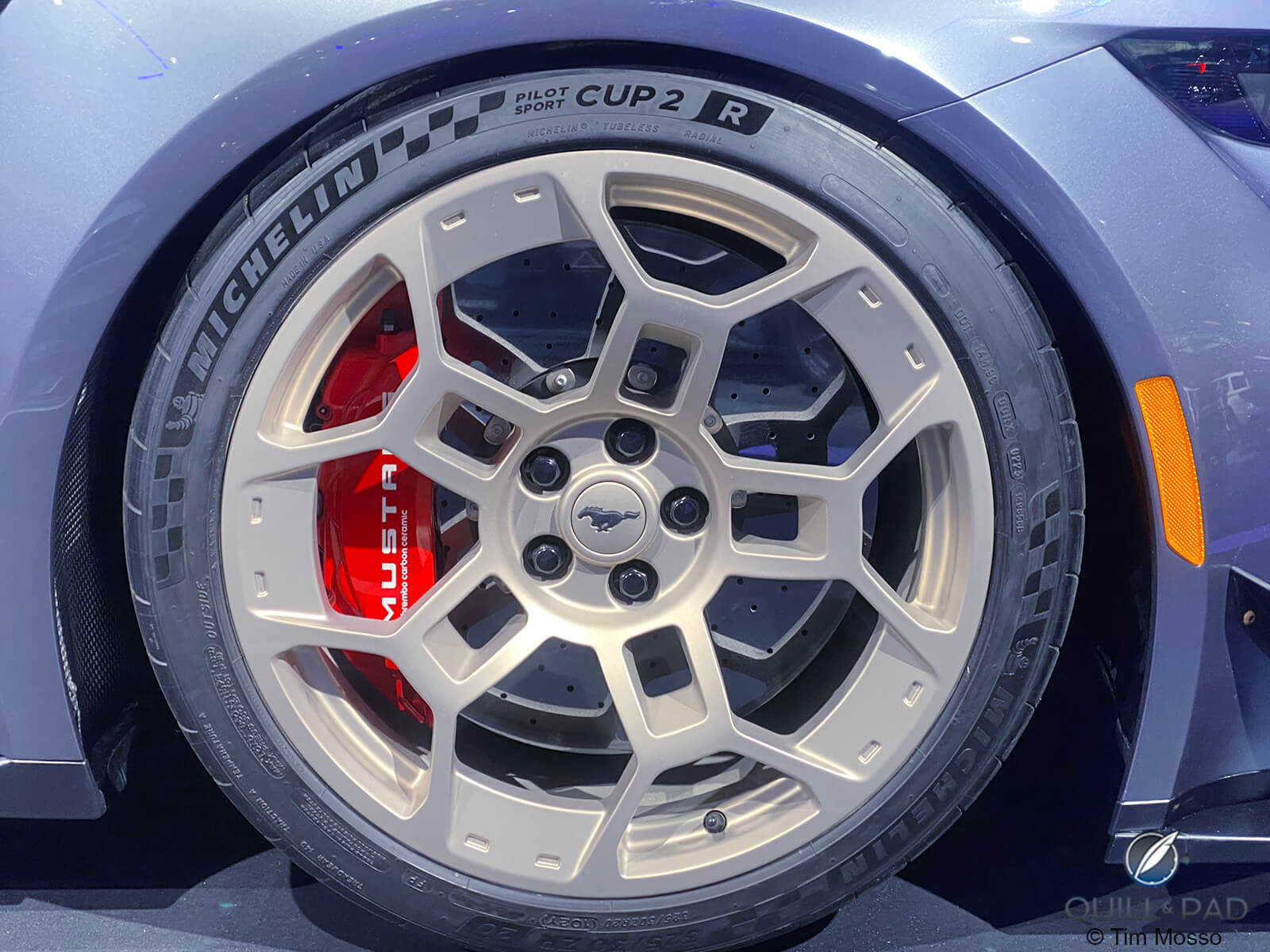
Ford Mustang GTD wheel
Accessories on the Mustang GTD are suitably spectacular. The 20” wheels are genuine magnesium, forged, and they ship full-blown R-compound Michelin Pilot Sport Cup 2s.

Massive Ford Mustang GTD carbon ceramic brake disk
Carbon ceramic discs the size of New York pizzas whizz through Brembo calipers.
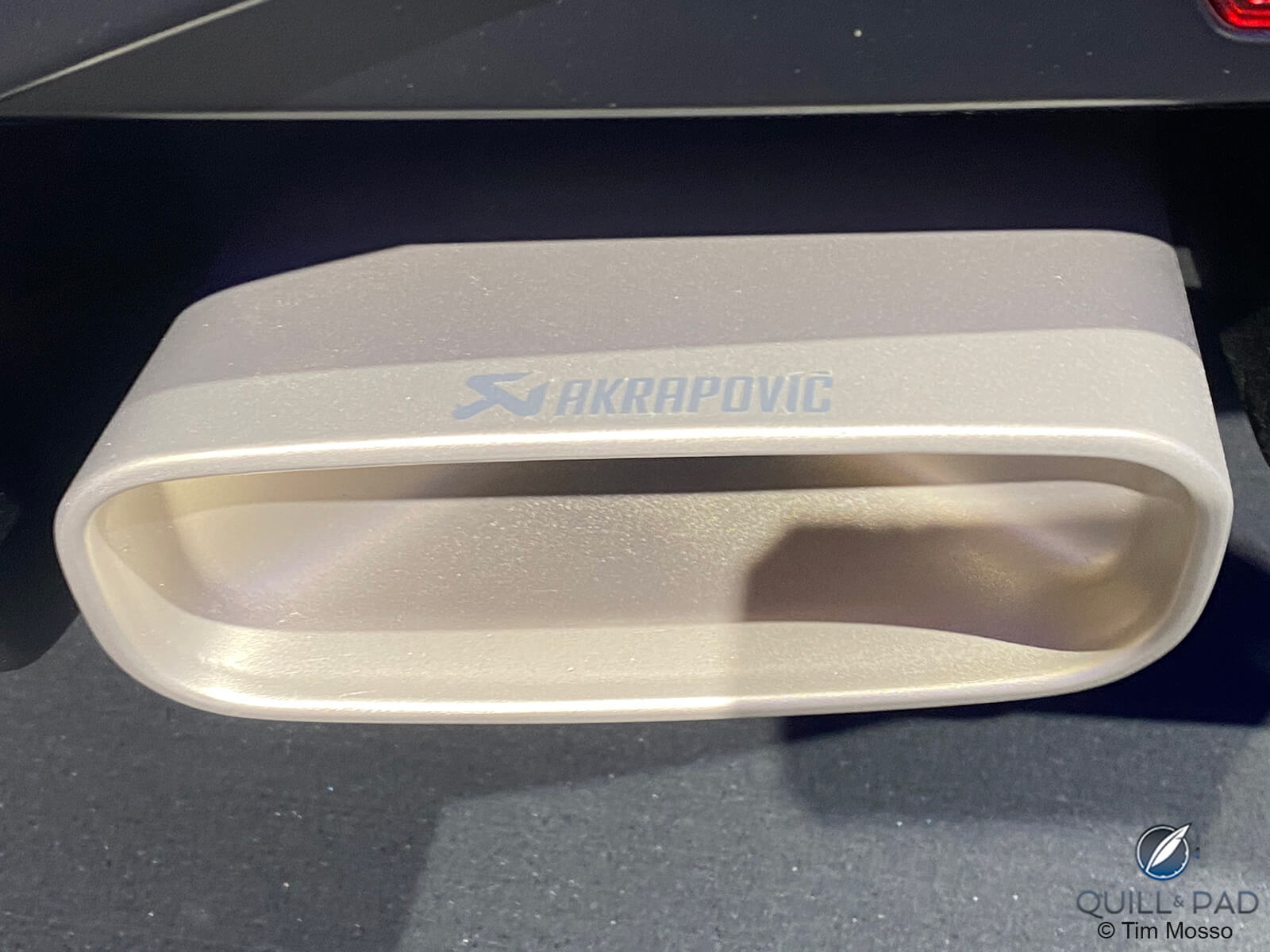
Ford Mustang GTD custom Akrapovič exhaust
Hardcore custom exhausts from Slovenian specialist Akrapovič exit the rear like jet nozzles; the last time I saw an Akrapovič system on a car at the New York show, it was on a million-dollar Koenigsegg. Every GTD mechanical system has a dedicated cooling circuit for sustained track lapping; the ones for the differential and gearbox occupy the former trunk cavity.
And to remind everyone it means business, Ford leaves the standard ‘stang’s rear seats sitting on the curb.
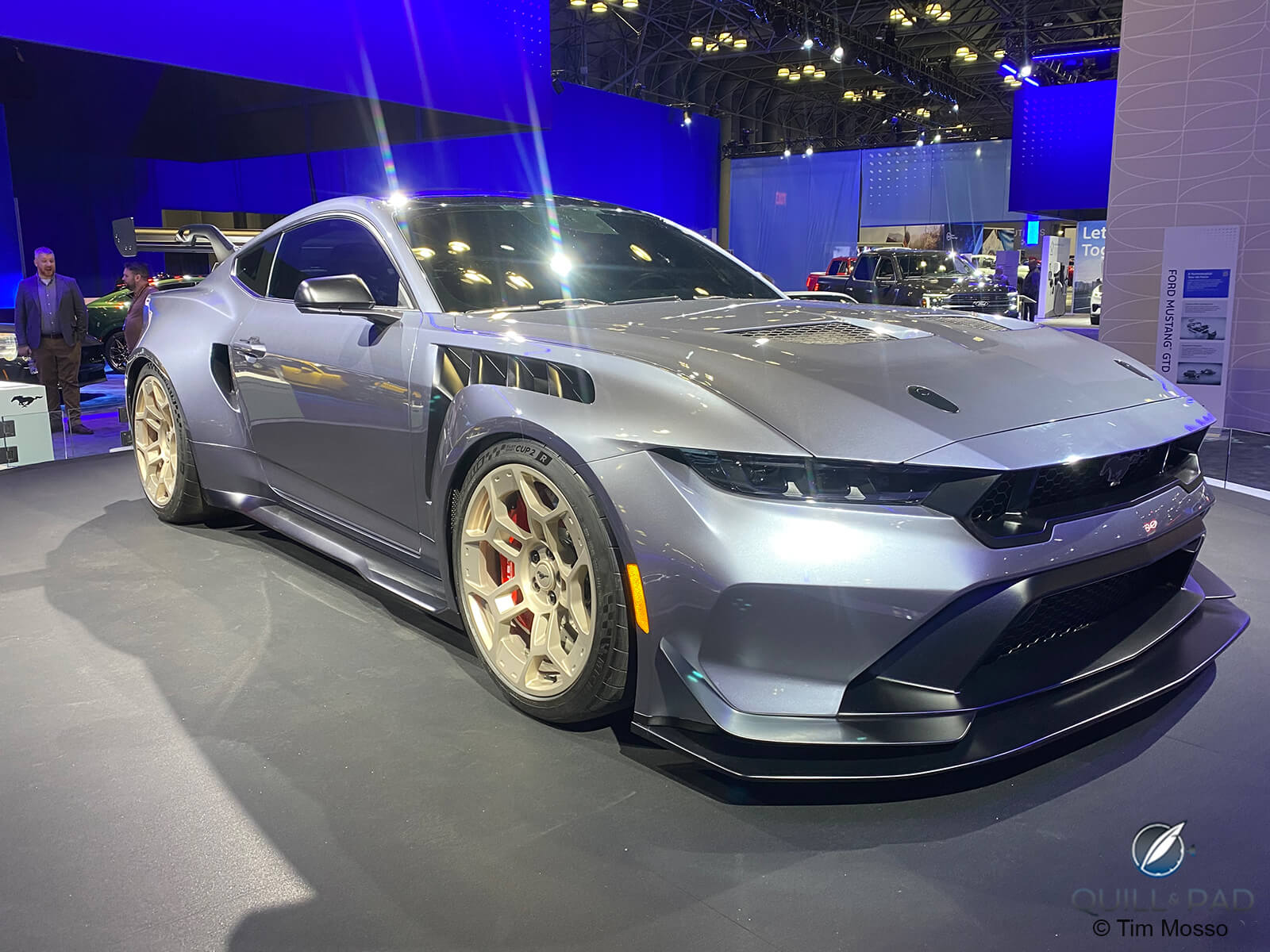
Ford Mustang GTD
Big performance usually carries a big price tag, and that’s the case with the Mustang GTD. Production of 2,000 units is planned with each example retailing for $300,000 before options. Reportedly, Ford is flexible about expanding the production total if demand exists; the price, however, is non-negotiable.
Even at $300K, the line to ride this steed will wrap around a New York City block. More info about the Mustang GTD is coming, but it must wait until Ford’s new performance flagship is closer to delivery.
———————————————————————————
———————————————————————————
Lamborghini Revuelto
Not all petrochemical performance rides solo these days, and that’s a good thing. Most serious hypercars – and premier-class Le Mans racers – have been hybridized for over a decade.
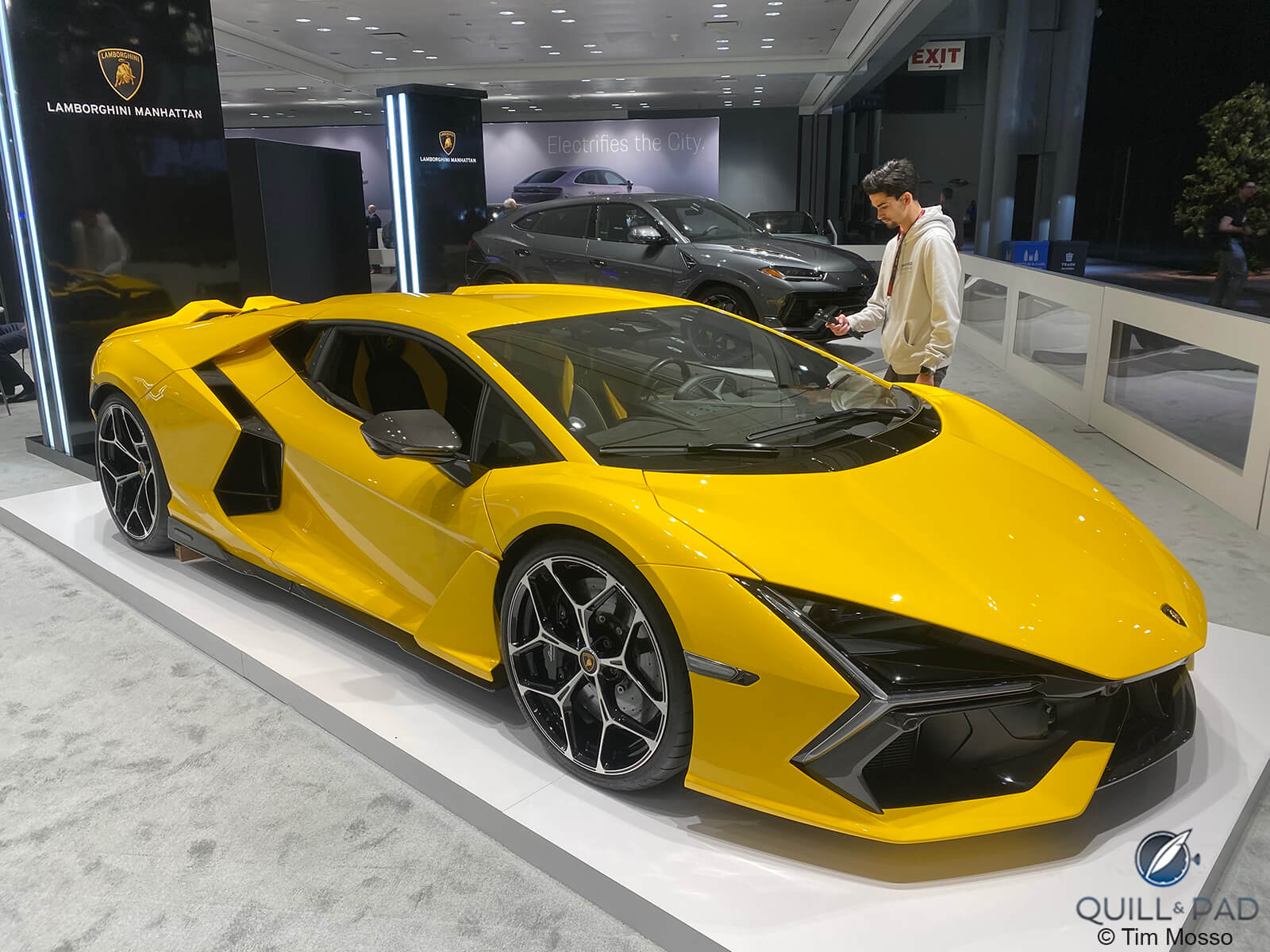
Lamborghini Revuelto
The Lamborghini Revuelto, new for 2024, combines a 6.5-liter V12 with three electric motors to yield 1,001 horsepower and an outrageous 0-125mph time of seven seconds.
In 1976, Road & Track magazine clocked the original Lamborghini Countach – a pioneering supercar – at 6.8 seconds to 60mph. Given the same interval, the Revuelto hits more than twice the velocity on its way to a terminal (terminally insane?) top speed of 217mph.
Yes, Revuelto has a theoretical 9.6km electrical range, but presumably that’s just for valets to park the thing in Beverly Hills. And it doesn’t really matter, because 1,001 horsepower!
Not only is the Revuelto the direct descendant of the bedroom poster icon Countach, but it traces its roots all the way back to the 1966 Lambo Miura, a proto supercar that defined the breed. That said, the newest V12 Lamborghini is designed to be easier to live with.
Since its 1998 acquisition of Lamborghini, Volkswagen – via Audi – has worked to exorcise the demons that made traditional Lamborghinis as tiresome to endure as they were spectacular when they worked.
The times have moved on since the steel tube frames of the Countach and Diablo. Lamborghini builds each Revuelto around a core carbon fiber monocoque similar to that of a modern Le Mans prototype. The bodywork is a shell of comparably autoclaved carbon weave.
There’s torque-vectoring, rear-wheel steering, and all-wheel drive puts the power down without exception.
That said, so much of the Lamborghini legend is built on style, and the Revuelto drips with it. This isn’t a car for the shy – it’s the rolling equivalent of Jacob & Co’s ocular overloads. Need an Astronomia Tourbillon for the road? Call Lamborghini.
Look at the deck over the engine – or the lack of one. After years of putting the hardware on display below Plexiglas, a supercar designer decided to do away with the plastic canopy altogether.
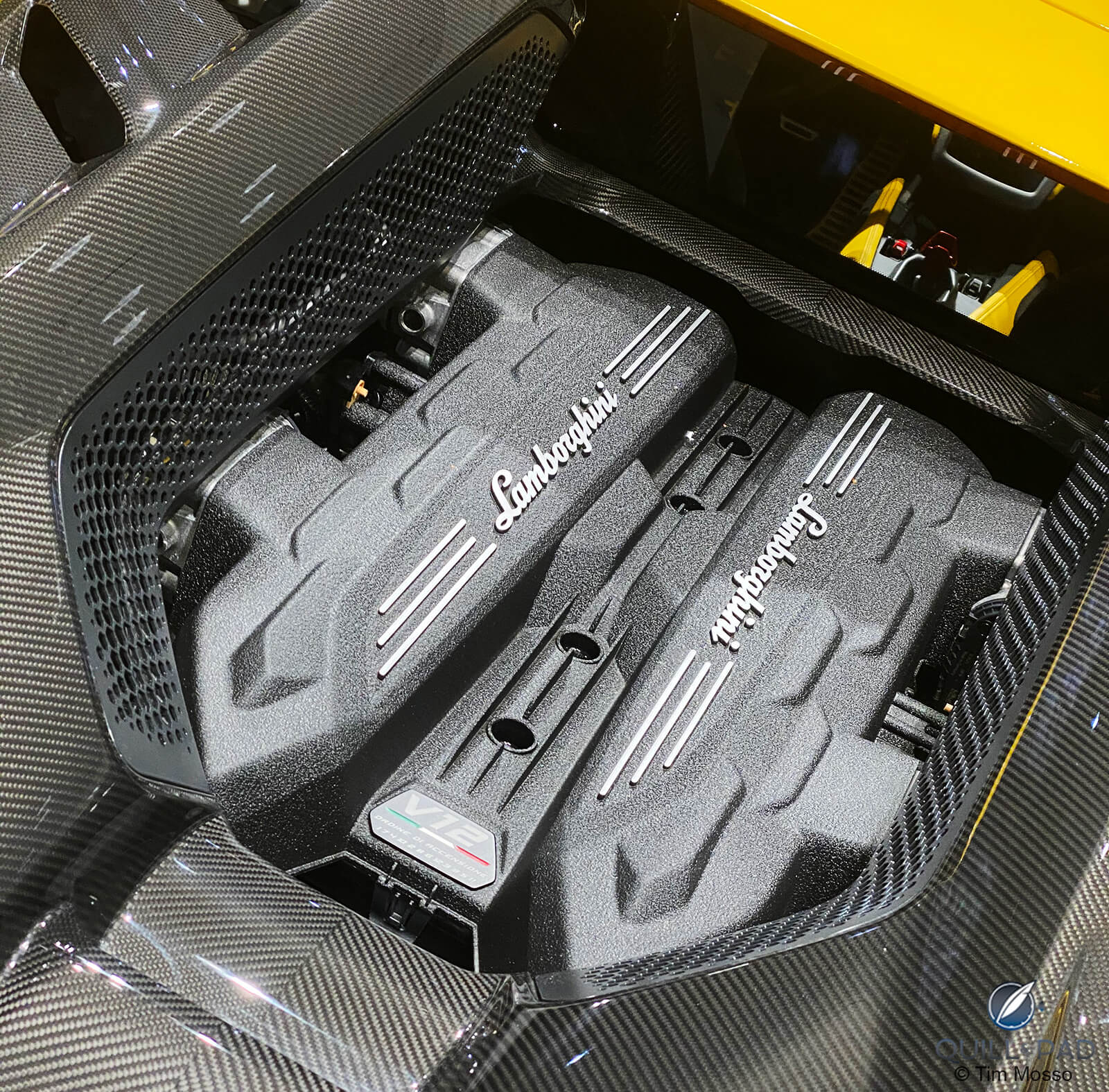
Lamborghini Revuelto V12 engine
The Revuelto’s open valley over the V12 is pure extrovert arrogance; you either love it or hate it, just like the car. Upwind of the mill, a double-bubble roofline emphasizes that this missile has been shrink-wrapped around its two occupants.
The front end of the Revuelto is designed with aerodynamic downforce foremost, but it also looks positively hostile. It’s an automotive stiletto rising in your rearview mirror; “get out of the way or get cut out of the way.”
Active aerodynamics front and rear ensure the Lambo can live up to its boast. It’s not small, either. At 4,947mm (194.8in), it’s as long as an E-Class Benz.
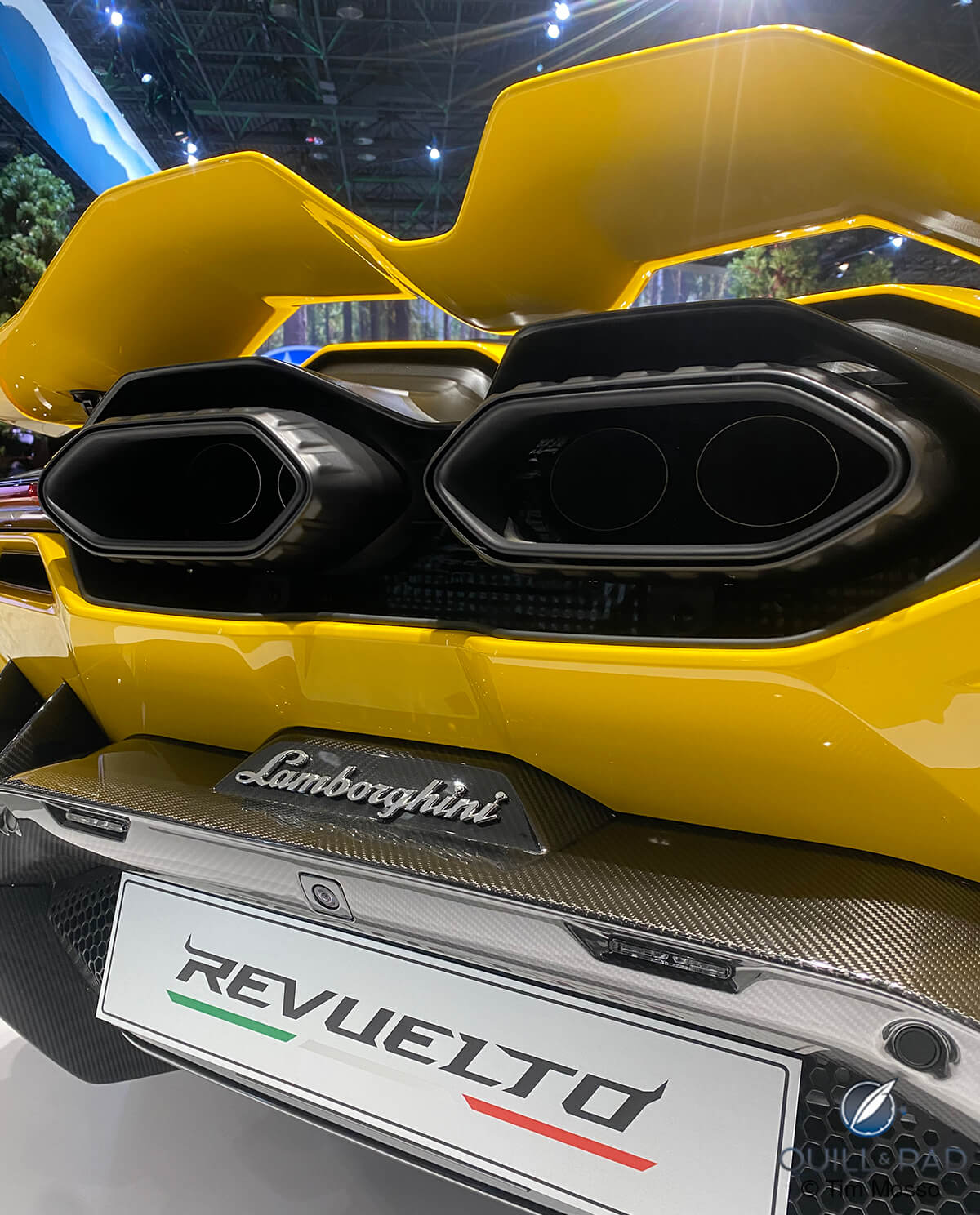
Lamborghini Revuelto exhausts
A car that goes like a rocket should look like one, no? At least, that’s how it comes together. The Revuelto’s exterior style is credited principally to German auto designer Mitja Borkert, and he didn’t hold back. Speaking of “back,” this car has it.
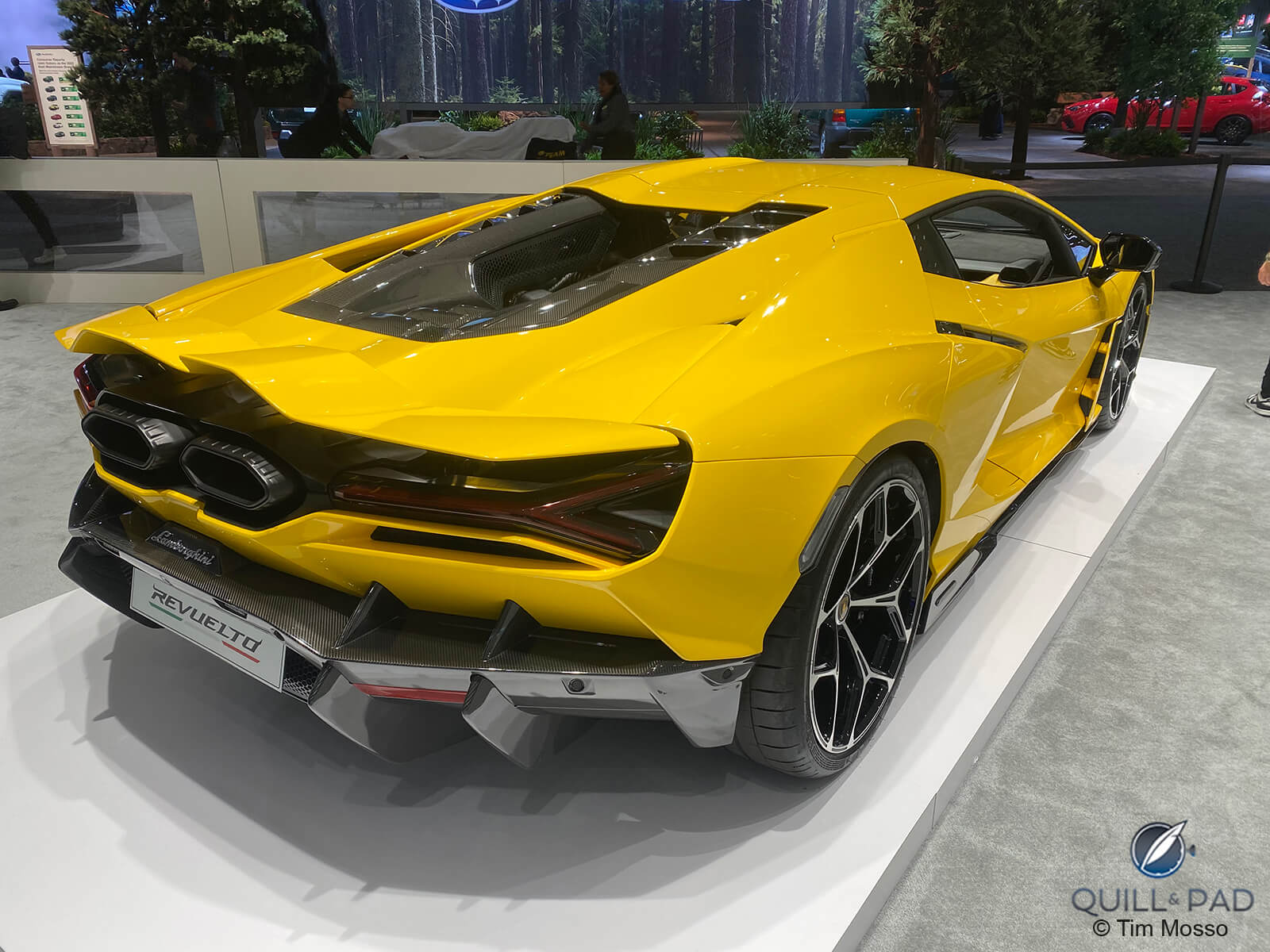
Wild from any angle: the Lamborghini Revuelto
The mid-engine mass emphasis shifts the visual center of gravity aft, and the exhaust nozzles – these don’t “muffle” anything – thrust outward like the business end of a Concorde. Situated between a movable rear wing and the road-legal-world’s largest downforce diffuser, those banshee stacks scream at a redline of 9,500rpm.
Rolling stock is suitably mental. Staggered Bridgestone Potenza 265/35 ZR21s and 345/30 ZR22s look like absolute rubber bands; it’s hard to believe that these slivers of gumball-soft rubber even hold air.
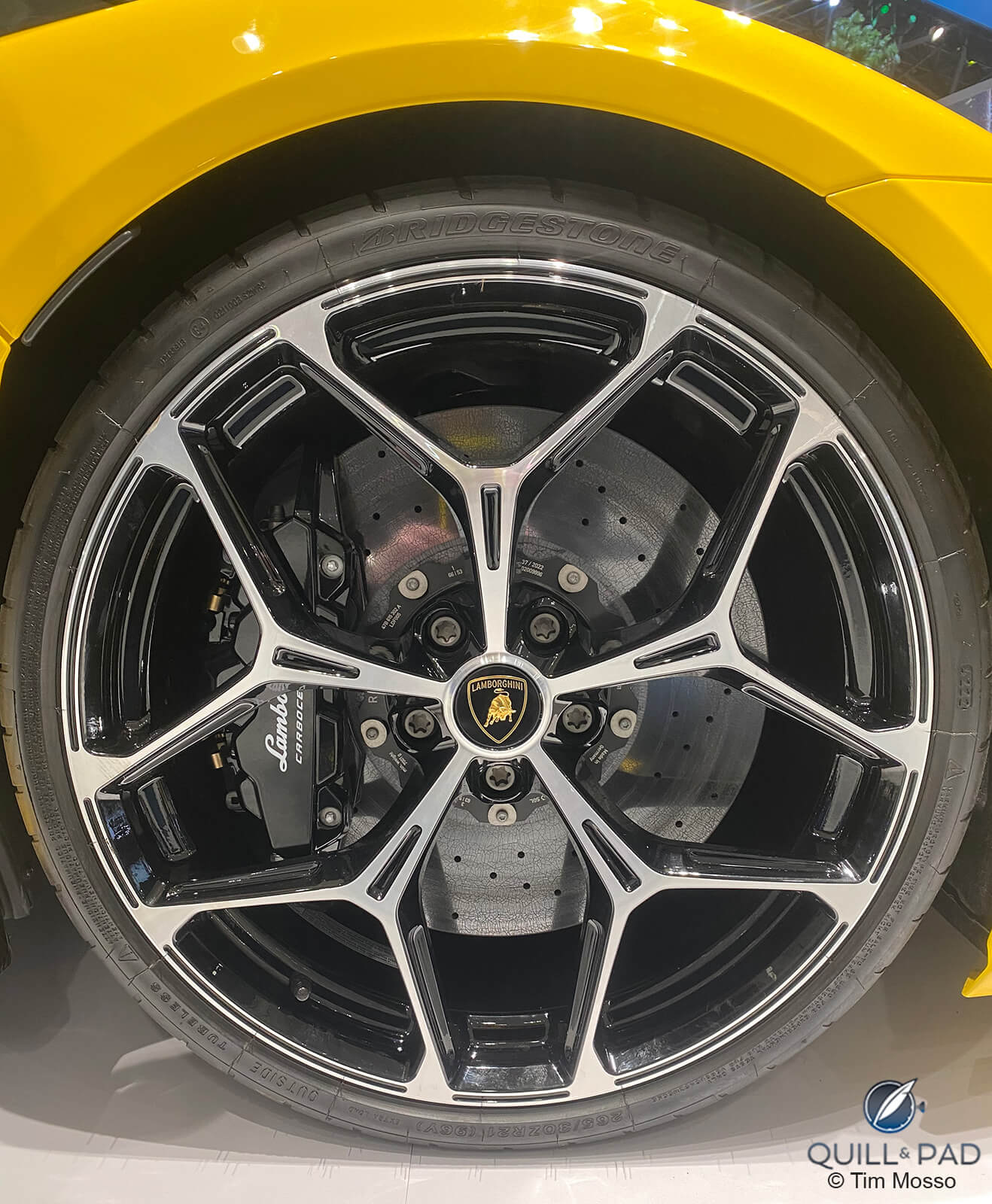
Lamborghini Revuelto wheel
The alloy wheels, hugely evacuated and spare, look too gossamer to handle all this fury. And because this is an Italian supercar, even the carbon ceramic brakes look cool. The 410mm front and 390mm rear discs rivaled the size of the nearby NYC manhole covers.
Want one? According to the dealer at the show, at least two years of production is already sold out, and the queue is growing. Pricing starts just over $600,000 for folks of means willing to slow-walk their fast cars.
———————————————————————————
———————————————————————————
Nissan R35 GT-R
Nissan’s R35 GT-R was hailed as a performance car for the ages when it arrived on the market in 2009. Given 16 model years, it lived up to the “ages” billing. As the latest and possibly last internal combustion vehicle to carry the 55-year-old GT-R moniker, the current model may go out in a blaze of glory after 2025.
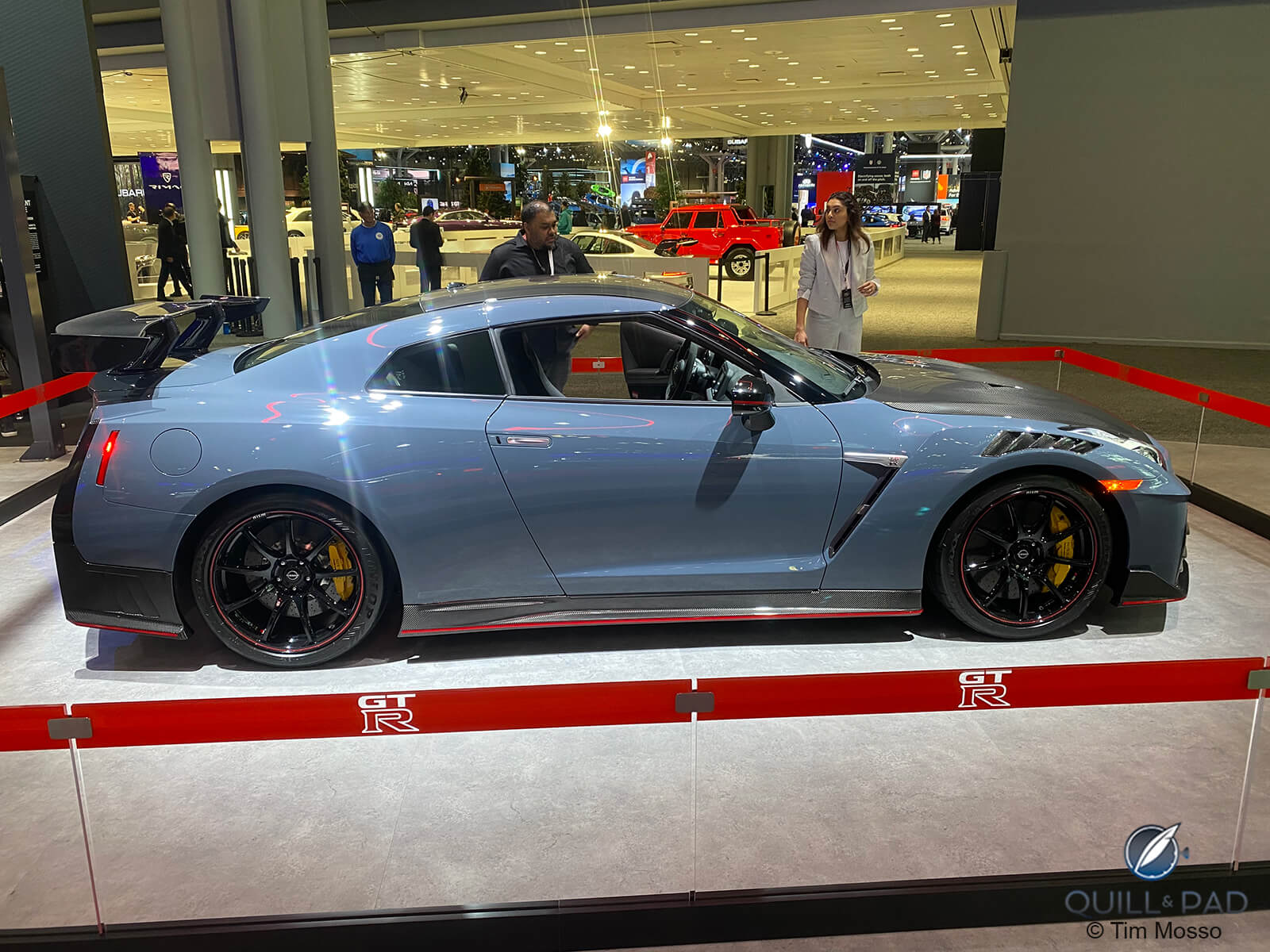
Nissan R35 GT-R
Nissan hasn’t committed to a sunset date, so the car nicknamed “Godzilla” continues its rampage for the time being.

Nissan R35 GT-R ‘Godzilla’
Although a mid-tier “T-Spec” model arrives for ’24, the king of the monsters remains the GT-R Nismo. Conceived and named after Nissan’s in-house performance and racing division, the Nismo version of the car is the most expensive and explosive by far. “Nismo” status commands a bonkers 81.3 percent surcharge over the entry-level “Premium” version of the GT-R. But $222,895 buys the full fire breathing version of Gojira.
A twin-turbocharged and aftercooled V6 feeds a dual-clutch six-speed gearbox. Six gears isn’t as impressive as it was in 2009, but there’s enough torque to compensate for the lack of ratios.
All-wheel drive with torque biasing connects the power to the pavement. Motivation is vectored by a mechanical front differential and electronic limited slip rear.
Sub-three-second 0-60 runs otherwise the domain of EV supercars are routine Nismo territory according to the Nissan staff on hand. Sub-11-second quarter miles come standard.
Sure, 600 horsepower and 481lb-ft of torque might not sound as imposing in an era of 1,000hp+ hypercars, but the Nissan staff seemed to regard the quoted numbers as an insurance play; reality is higher. The engine was said to be matched, balanced, and blueprinted in a fashion unique to the Nismo, but details were scarce.
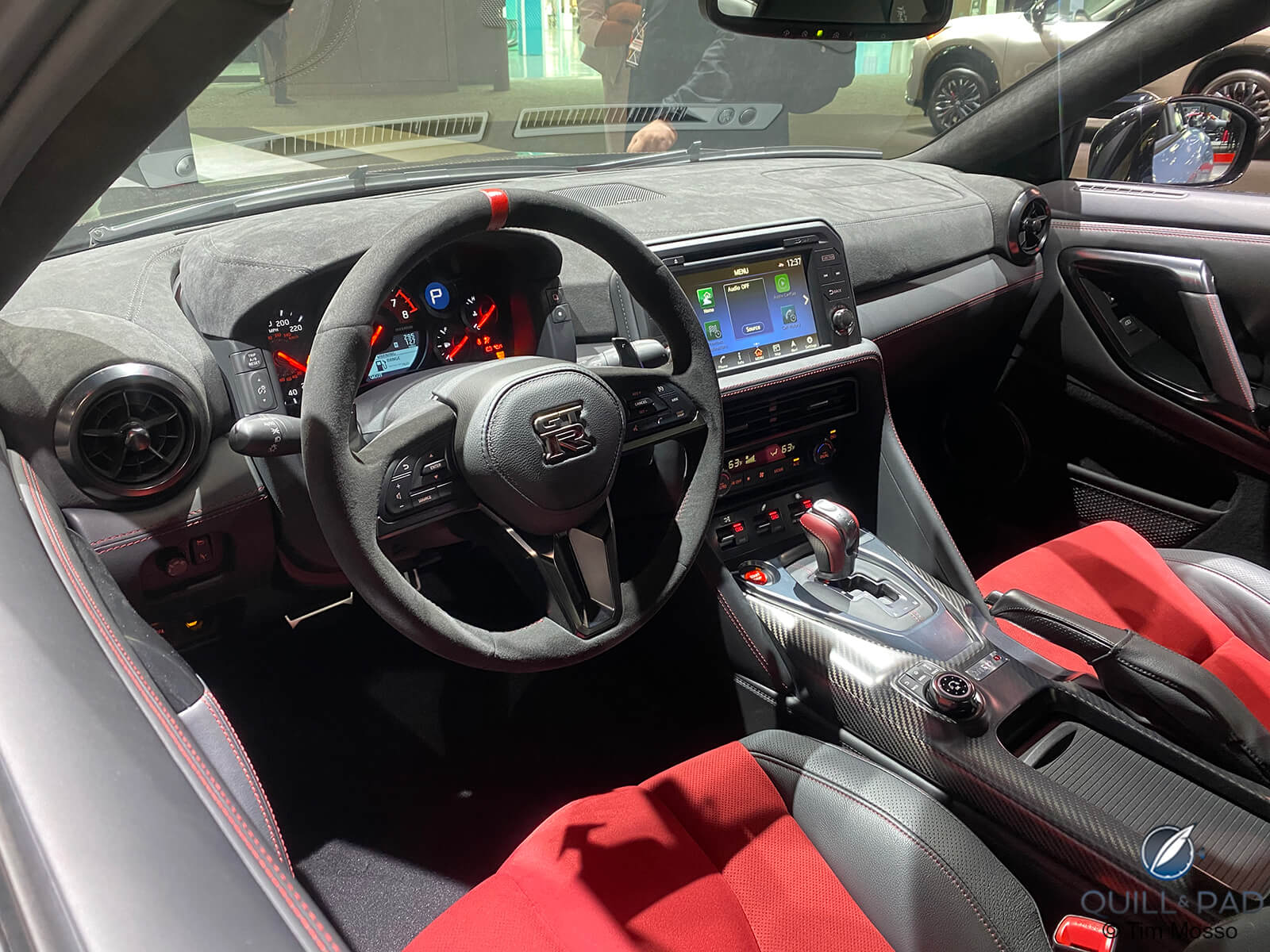
Nissan R35 GT-R interior
Unlike most of the iron at the show and literally every single EV performance car, this generation of GT-R ranks among the Chevrolet Corvettes and Porsche 911s of the world with actual on-track wins and titles to its name.

Nissan R35 GT-R wheel
Japan’s performance icon relies on British marque Dunlop for its track performance tires, and Japanese-made RAYS forged alloys reduce unsprung weight.
Electronically adjustable Bilstein dampers keep the rolling stock planted. The Nismo GT-R featured here includes the Nismo Appearance Package that accounts for those sharp RAYS and the bare carbon fiber hood.
And the Nismo GT-R is a mountain of carbon. Your $100,000 investment beyond a “Premium”-spec GT-R buys vast swapping of metal panels with gorgeous clear coated carbon fiber weave. Hood, roof, splitter, wing, sills, diffuser; this car has more fiber than a can of beans.
Not only does the carbon fiber reduce weight, but it gives the Nismo an heroic gravity somewhere between the starting grid of WEC and the outlaw nocturnes of street racing. While painted body color, the front fenders and trunk lid also consist of autoclaved carbon.
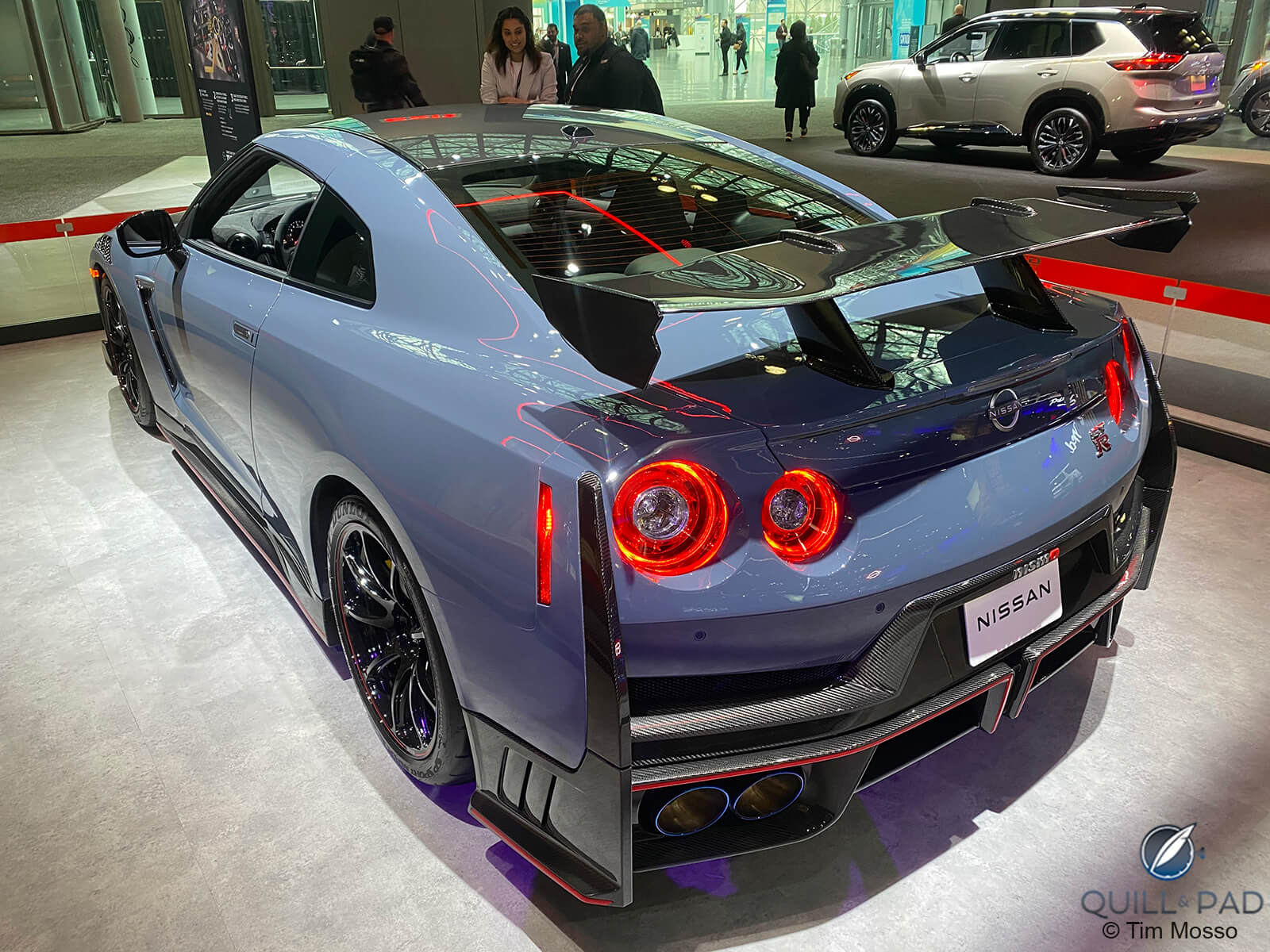
Back of the Nissan R35 GT-R
Above that trunk lid, Nissan applies the latest thinking in race aerodynamics with a “gooseneck” mounting for the wing. The idea is that a wing anchored from the leading edge and somewhat above the plane of the device will be more effective on track.
Nissan mentions specifically choosing a special resin glaze thin enough that the carbon weave of the wing is tactile – you can feel it with your fingers. Beneath the wing, the GT-R’s iconic four round taillights sit ready to greet all but the stoutest challengers.
Carbon gilding extends even to the interior of the Nismo GT-R. Emphasis on “gilding,” because this part is purely ornamental. More functional – but still cool – are the massively bolstered track-ready thrones from German performance seat leader, Recaro. Alcantara premium synthetic sued graces the steering wheels, and similar but Recaro-sourced material serves the seat inserts.
Because this is a GT-R, not even the rare-for-a-supercar back seats can save you from monumental insurance premiums. There’s Apple CarPlay, but do you care?
———————————————————————————
———————————————————————————
Chevrolet Corvette Z06
Chevrolet’s Corvette is an often-misunderstood creature. The car’s dual mandate of uncompromising performance and attainable price of entry is a conflicting burden that cost-no-object Porsche 911s and V8 Ferraris need not bear.
Yet, due to the performance side of the equation, the Corvette generally finds itself compared to this kind of performance peer. Confusion arises while attempting to reconcile Porsche-level performance with Chevrolet-sourced details.
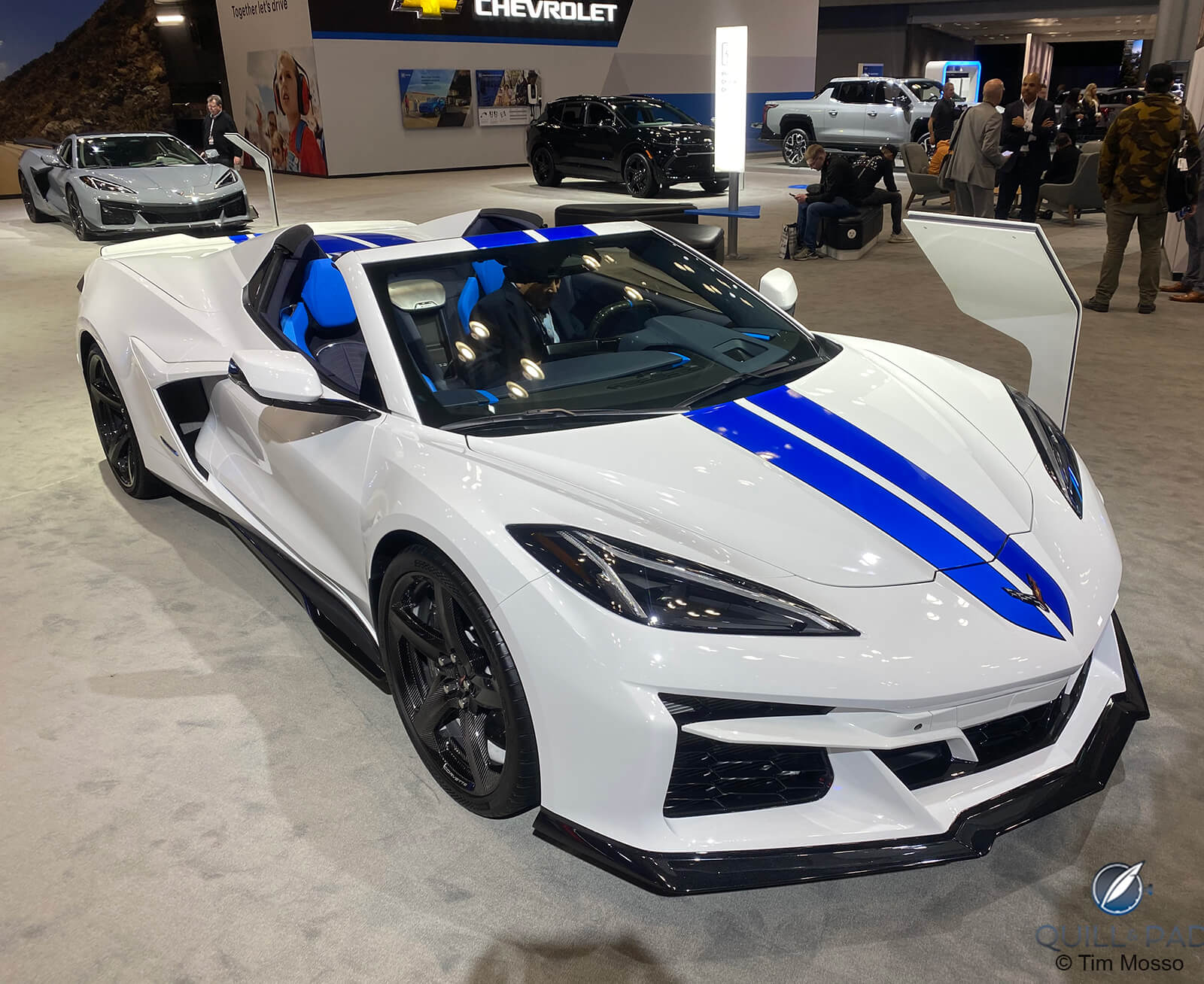
Corvette Z06
No longer. The eighth generation Corvette, which was new for 2020, starts from a world-class baseline. In exchange for accepting certain tradeoffs such as higher entry prices and the end of manual transmission options, Corvette buyers get a car that looks like, feels like, and is a world-class product. All the qualified praise of the past can be retired when Vettes like the 2024 Z06 roam the earth.
Truth be told, the Z06 was hiding in plain sight before its 2023 launch. Corvette Racing’s IMSA GT2 entry was described as a “C8.R,” but the otherworldly wail of its engine suggested something beyond a typical GM small block. It turns out the race car was a track-based testbed for the unreleased performance variant, and a flat-plane crankshaft was the secret.
The 2023 Z06 arrived 33 years after the first Lotus-engineered LT5 introduced four-valve/four-cam heads to the Corvette V8. Making up for lost time, GM’s LT6 added the flat-plane crank to Lotus’ original multivalve formula.
A true race engine, the LT6 employs the flat-plane crankshaft to reduce rotating mass. Unlike a cross-plane crank, a flat one can exploit even firing intervals and superior inherent balance to run without counterweights.
Counterweights generally add dozens of pounds to an engine this size, so removing them permits dramatically faster throttle response. When paired with a lightweight flywheel, the flat-plane concept allows the naturally aspirated LT6 to reach its powerband faster than any prior Vette engine.
Additional refinements including direct injection and variable valve timing join the LT6’s roster of tricks. Dry sump lubrication relocates the oil pan from below the crankshaft to a remote reservoir. Not only does this avoid oil starvation under hard cornering conditions, but it also lowers the entire engine assembly to reduce the Corvette’s center of gravity. In a rarity for a production car, the Z06 is equipped with four-into-two-into-one stainless steel headers for optimal exhaust flow and back pressure.
Further reduction of parasitic losses comes from the replacement of the standard Corvette’s steel valves with the LT6’s titanium units; valve springs are doubled for strength. All major internals are forged, and the connecting rods are titanium. Even on the road, it runs 12.5:1 compression like a real race engine. Added to the flat-plane crank, these upgrades permit an 8,600rpm redline.
In total, the LT6’s legion of refinements yields an engine that produces 670 horsepower from 5.5 liters of displacement. It is the most powerful naturally aspirated V8 available in the world on a production car and the most powerful NA V8 of all time.
Second place goes to the 622 horsepower AMG-built M159 in the 2013-2014 Mercedes-Benz SLS AMG Black Series. Even then, the AMG needed 700cc more than the Corvette to make that 622hp.
The rest of the Corvette Z06 lives up to its engine. A widebody kit with functional aerodynamics and considerable carbon fiber keeps pace with the Nismo GT-Rs of the world. Chassis width and tire scale are proportional to the fender flares. Top-spec Z06s can be had with “GT2” seats that include race-like bolstering and pass-throughs that look ready for racing harnesses.
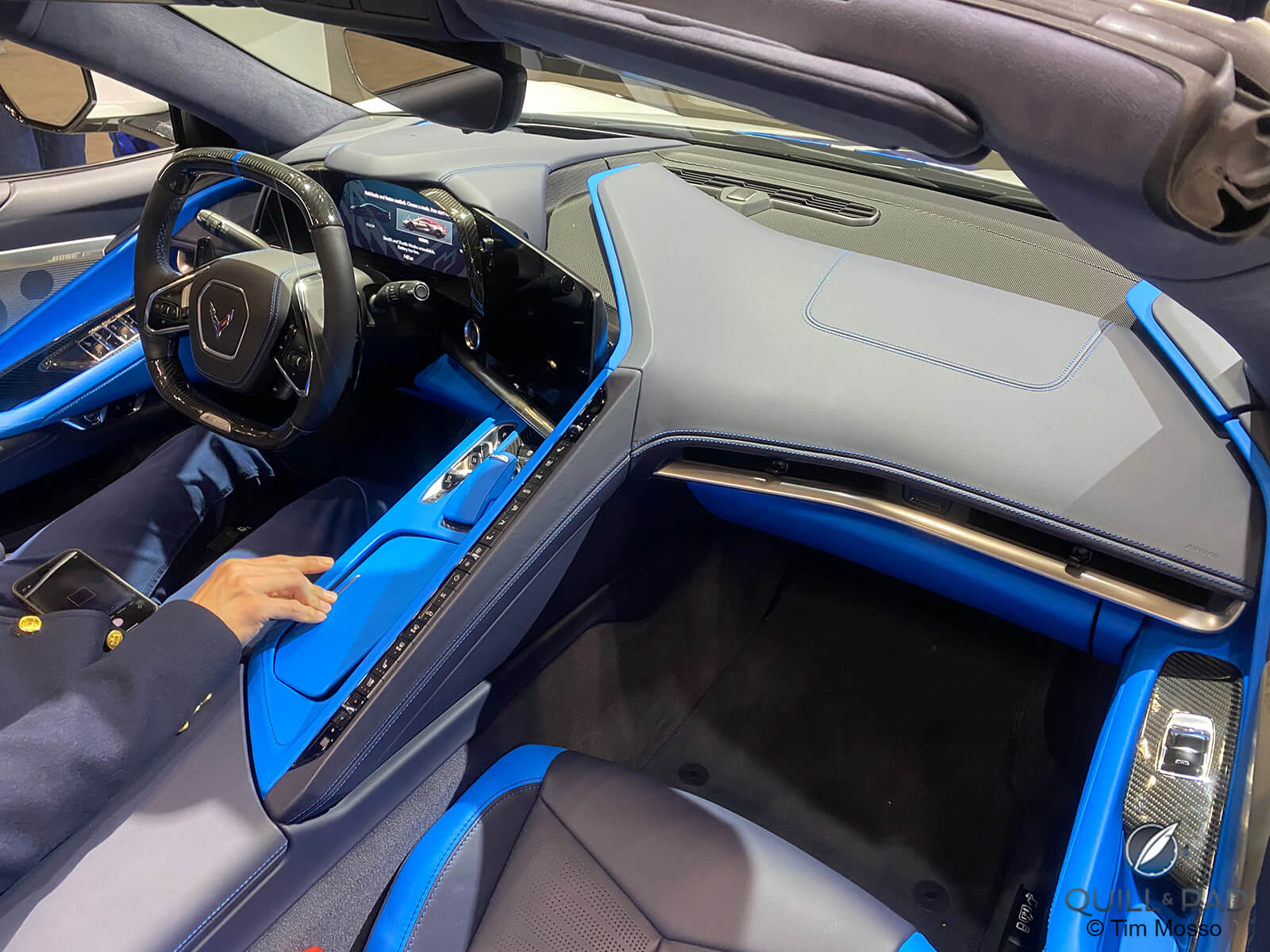
Corvette Z06 interior
The interior, while perhaps over-styled, is premium in its materials, fit, and finish. The age-old Corvette qualifiers like “good for the price” no longer apply; this is a world-class cockpit.
A Z07 package raises the performance stakes for $9,000. Its Brembo carbon ceramic binders offer hot-lap longevity for the owner’s next track day. Real time magneto rheological dampers – a technology pioneered by GM in the early 2000s – pair with Chevrolet’s PTMS, a modified stability control system tuned specifically for the track.
The Z07 option requires bundling a carbon package that brings an even bigger wing than standard. This wing and other aero hardware produce over 700 pounds of downforce at speeds beyond 180mph.
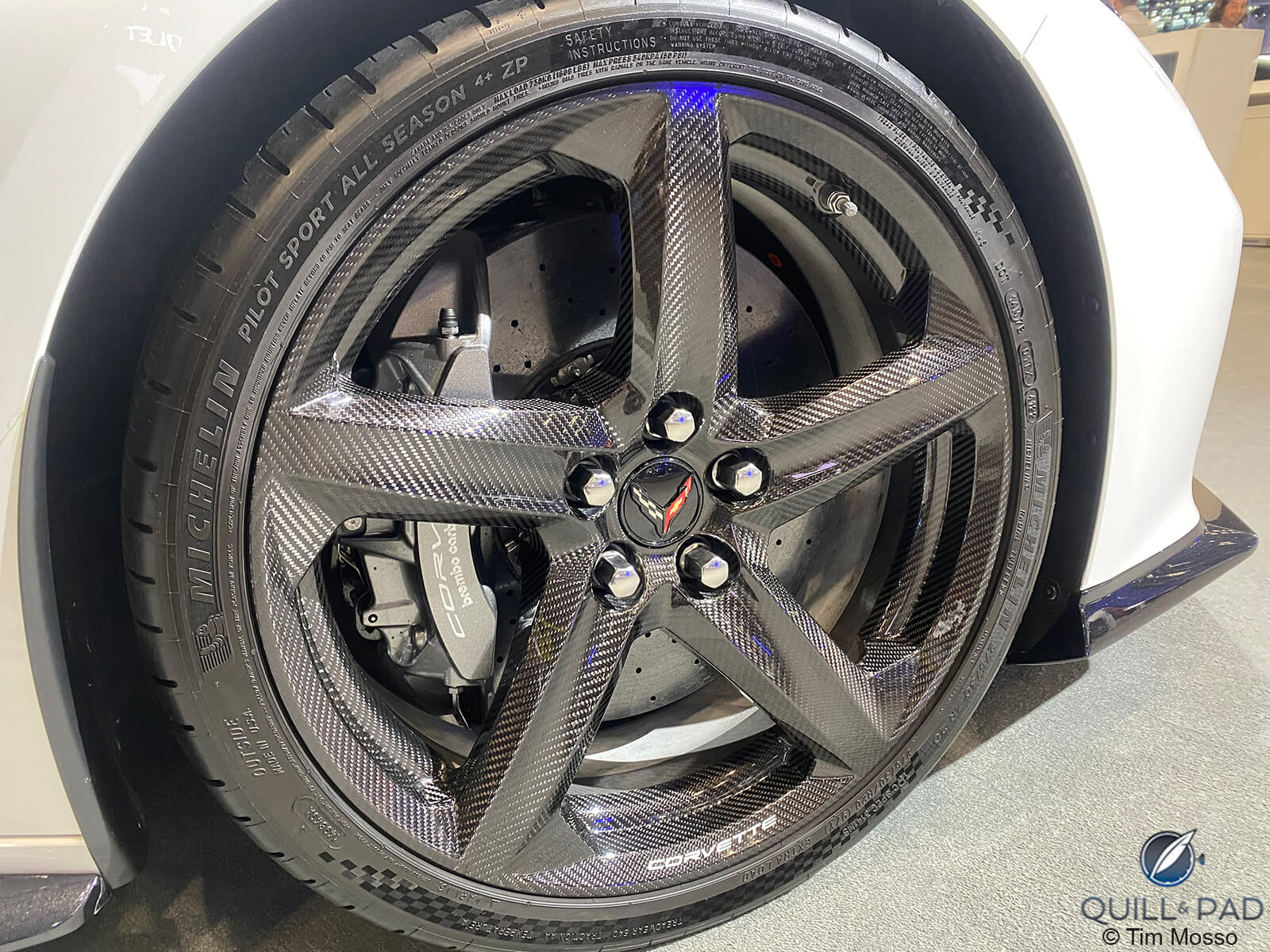
Corvette Z06 wheel
A standalone $15,500 carbon fiber wheel option looks ready for Laguna Seca, saves 41lb of unsprung weight, and comes paired with summer performance tires (oddly, the show car wore all-seasons). Michelin Pilot Sport Cup 2 R-compound tires come with the Z07 performance package.
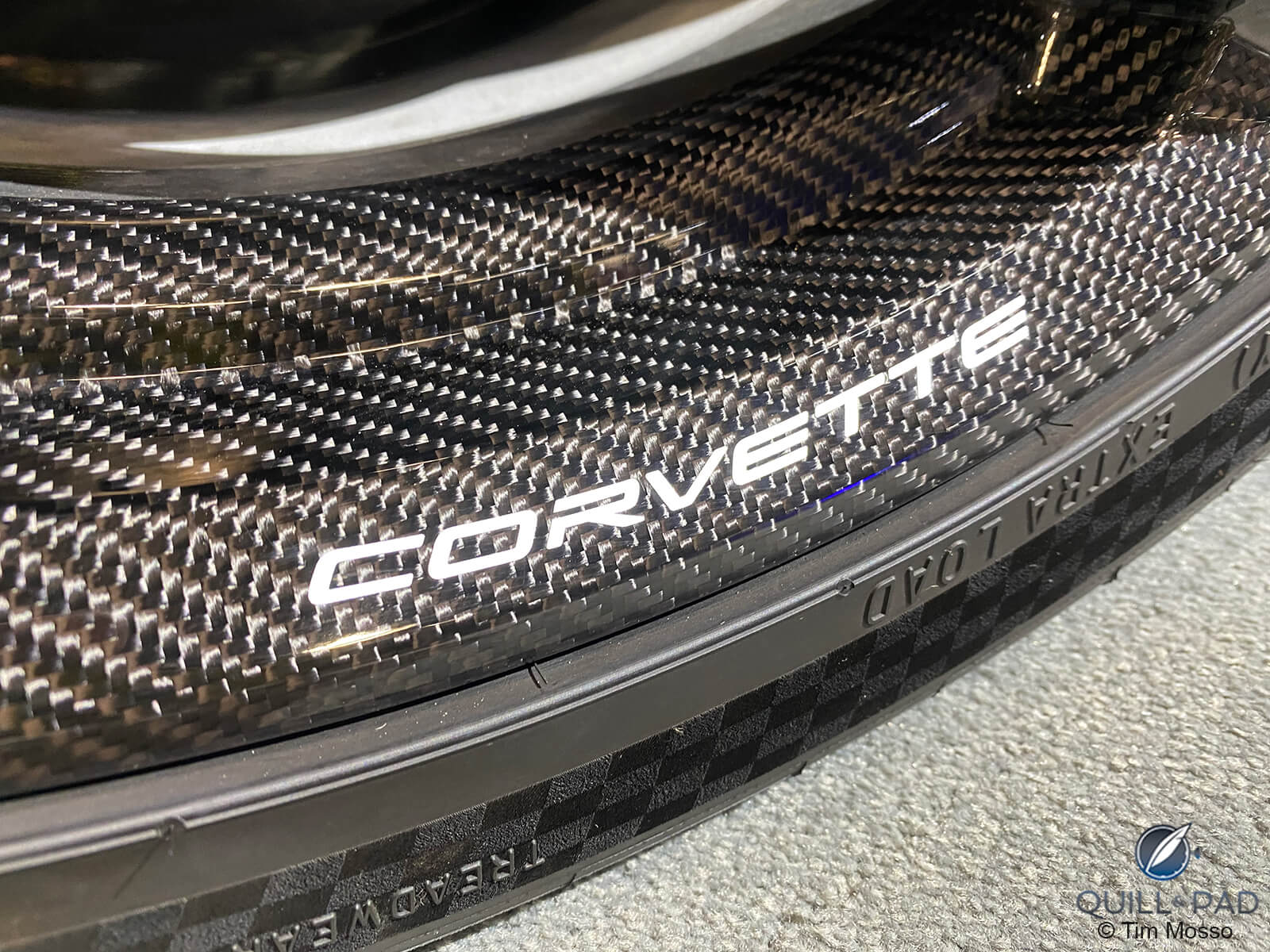
Bespoke tire of the Corvette Z06
Chevy literature took pains to emphasize that using these road-magnet tires in any but warm conditions will turn the Z06 into an unguided missile.
Performance is impressive to say the least. While older front-engine Corvettes often struggled to lay down huge torque, the now rear-biased C8 platform enjoys the same inherent advantages as Porsche 911 and mid-engine Ferraris. As a result, the Z06’s 2.6-second 0-60 run is the quickest in Corvette history. Quarter mile runs in the mid-10s at over 130mph are claimed, and Chevrolet quotes lateral grip of 1.22G with the full-fat Z07 equipment fitted.
While all Corvette Z06 models include at least a removable targa top, the dedicated convertible version includes a retractable hardtop. Once ubiquitous on convertibles of the 2000s and early 2010s, retractable hardtops have become rare over the past decade. Like convertible McLaren supercars, the Z06 Convertible employs a power folding hardtop that’s designed to produce a convincing coupe profile when raised.
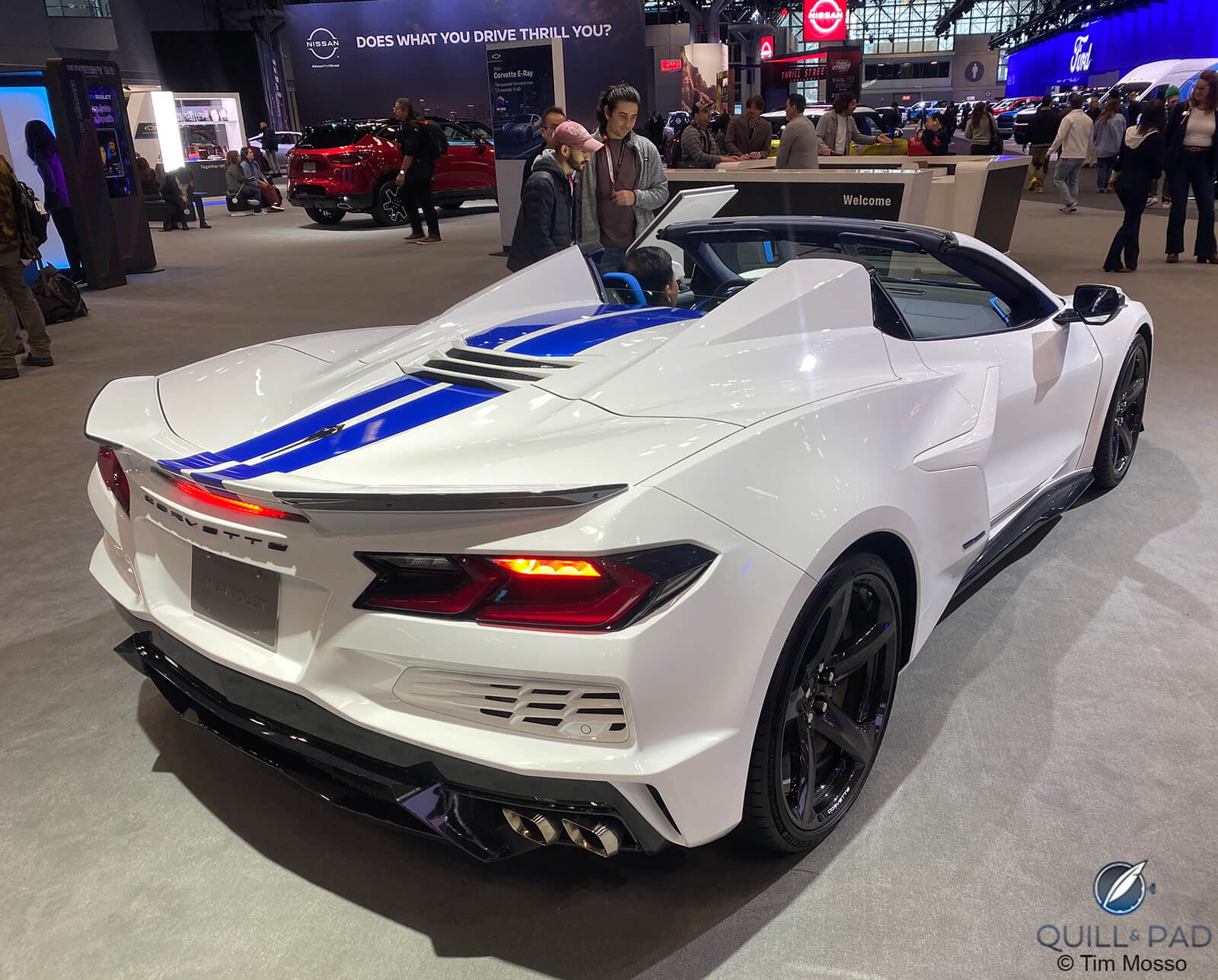
Corvette Z06 from the back
Aside from masking the exterior visibility of the engine, the stowable roof is nearly indistinguishable from the targa version when upright. And the weight penalty, long a sore point for hardtops, is only 101lb on the Corvette.
Electric vehicles and ride hailing apps have been the major automotive storylines of the last 15 years. New cars groan with electronics, connectivity, and technological distractions. Cars now drive themselves, and full autonomy is on the horizon. CES, once a summit for tech nerds, has practically turned into a car show.
But look closer, and it’s clear that car enthusiasts are living in a golden era of horsepower and performance.
Literally no 1960s muscle car or 1980s supercar can challenge even an entry-level V8 Mustang on the street or strip. While electric performance cars are expected, the high-water mark of internal combustion sports and supercars is at hand. While it’s likely that fewer new ICE road burners will debut going forward, this is a moment to enjoy.
The good old days are now.
For more information, please visit www.autoshowny.com
You might also enjoy:
Collecting Watches And Cars: What’s The Same And What’s Different?
Porsche 911 Carrera 4S (992): A Twin-Turbo-Powered Evolution
Leave a Reply
Want to join the discussion?Feel free to contribute!



Thanks Tim for a good weekend read. I understand your passion for cars and lament at the car shows of old.
I’d recommend heading to the UK for the Goodwood Festival of Speed. Part auto show, part classic car meet, genuine hill climb race and more.
All the best, Ed